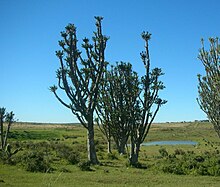
Euphorbia is a very large and diverse genus of flowering plants, commonly called spurge, in the spurge family (Euphorbiaceae). "Euphorbia" is sometimes used in ordinary English to collectively refer to all members of Euphorbiaceae, not just to members of the genus. Some euphorbias are commercially widely available, such as poinsettias at Christmas. Some are commonly cultivated as ornamentals, or collected and highly valued for the aesthetic appearance of their unique floral structures, such as the crown of thorns plant. Euphorbias from the deserts of Southern Africa and Madagascar have evolved physical characteristics and forms similar to cacti of North and South America, so they are often incorrectly referred to as cacti. Some are used as ornamentals in landscaping, because of beautiful or striking overall forms, and drought and heat tolerance.

Euphorbia virosa, the Gifboom or poison tree, is a plant of the spurge family Euphorbiaceae. It has a short main stem, usually twisted, from which 5–10 cm branches emerge. These leafless branches have 5 to 8 edges. Paired thorns grow in regularly spaced intervals from the edges.
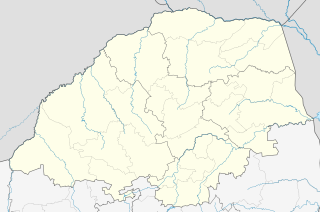
Mookgophong, also known by its former name, Naboomspruit, is a town in the Limpopo province of South Africa. The town is located approximately 42 km north-east of Modimolle and 51 km south-west of Mokopane.

Euphorbia resinifera, the resin spurge, is a species of spurge native to Morocco, where it occurs on the slopes of the Atlas Mountains. The dried latex of the plant was used in ancient medicine. It contains resiniferatoxin, a capsaicin analog tested as an analgesic since 1997.
Susan Carter Holmes is a botanist and taxonomist at the Royal Botanic Gardens, Kew. She discovered and catalogued more than 200 plants of the family Euphorbiaceae, particularly of the succulent East African members of the genera Euphorbia and Monadenium, as well as about 20 Aloe species. All plants and articles are published under her maiden-name Susan Carter.
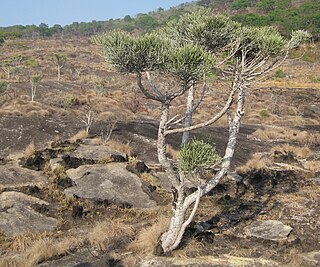
Euphorbia tirucalli is a tree that grows in semi-arid tropical climates. A hydrocarbon plant, it produces a poisonous latex that can cause temporary blindness.
Candelabra tree can refer to:

Euphorbia candelabrum is a succulent species of plant in the family Euphorbiaceae, one of several plants commonly known as candelabra tree. It is closely related to 3 other species of Euphorbia in particular; Euphorbia ingens in the dry regions of South Africa, Euphorbia conspicua from western Angola, and Euphorbia abyssinica which is native to a number of countries including Sudan, Eritrea, Djibouti, Ethiopia and Somalia.

Euphorbia poissonii, also known as Euphorbia poissoni and, incorrectly as Euphorbia poisoni is a highly irritant and toxic succulent member of the large and varied spurge family of plants. It is native to northern Nigeria, where local farmers extract its latex for use as a pesticide. Its powerfully irritant and pain-producing nature mandates use as a fencing plant.

The Euphorbiaceae are a large family, the spurge family, of flowering plants. In common English, they are sometimes called euphorbias, which is also the name of a genus in the family. Most spurges such as Euphorbia paralias are herbs, but some, especially in the tropics, are shrubs or trees, such as Hevea brasiliensis. Some, such as Euphorbia canariensis, are succulent and resemble cacti because of convergent evolution. This family occurs mainly in the tropics, with the majority of the species in the Indo-Malayan region and tropical America a strong second. A large variety occurs in tropical Africa, but they are not as abundant or varied as in the two other tropical regions. However, the Euphorbiaceae also have many species in nontropical areas such as the Mediterranean Basin, the Middle East, South Africa, and the Southern United States.
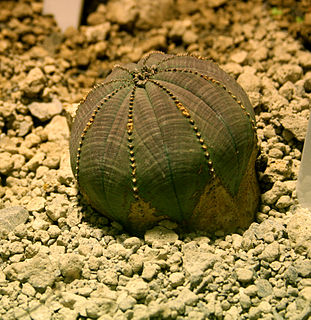
Euphorbia obesa is a subtropical succulent species in the genus Euphorbia. It comes from South Africa, especially in the Cape Province. Sometimes referred to as a Baseball plant.

Euphorbia hirta is a pantropical weed, possibly native to India. It is a hairy herb that grows in open grasslands, roadsides and pathways. It is used in traditional herbal medicine.

Euphorbia caput-medusae is a plant of the genus Euphorbia that occurs in and around Cape Town, South Africa.

The North-West University Botanical Garden on the Potchefstroom Campus of the North-West University (NWU) is the only botanical garden in the North West Province of South Africa. The Garden spans just under three hectares and is open to the public.
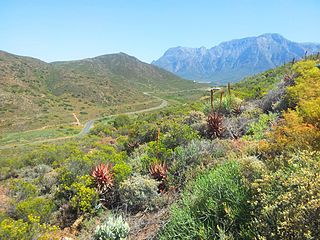
Robertson Karoo is a semi-arid vegetation type, restricted to sections of the Breede River Valley, Western Cape Province, South Africa. It is a subtype of Succulent Karoo and is characterised by the dominance of succulent plant species, and by several endemic plants and animals.
The Baynes Mountains are a mountain range in Namibia.
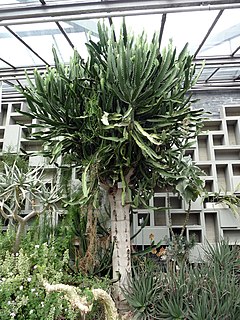
Euphorbia triangularis, commonly known as river euphorbia, chandelier-tree or tree euphorbia, is a species of plant in the family Euphorbiaceae native to southern Africa.

Euphorbia globosa, commonly known as globose euphorbia or globose spurge, is a species of plant in the family Euphorbiaceae native to southern Africa.
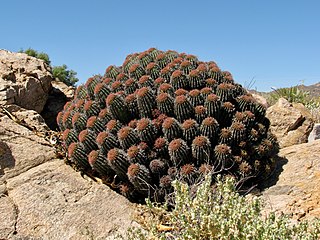
Euphorbia stellispina is a species of flowering plant in the family Euphorbiaceae endemic to southern Africa. It is locally known in Afrikaans as skaapnoors, sterretjie-noors, or Karoo noorsdoring. Euphorbia stellispina grows in rocky areas of karroid shrublands.
